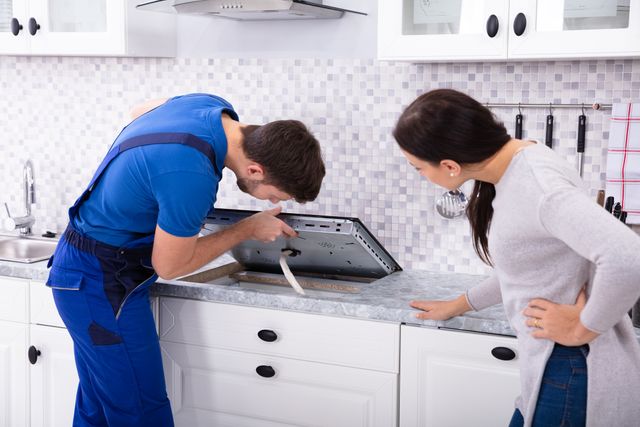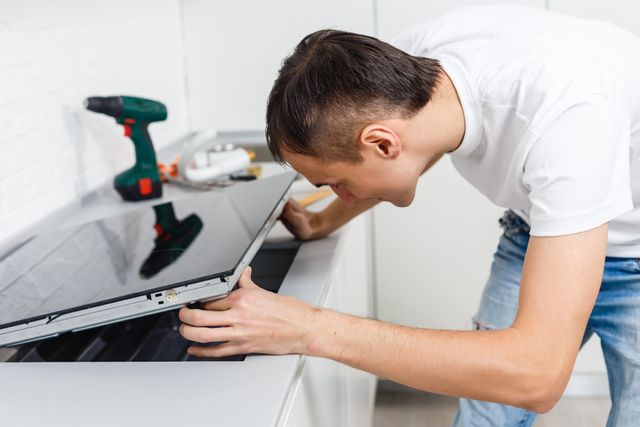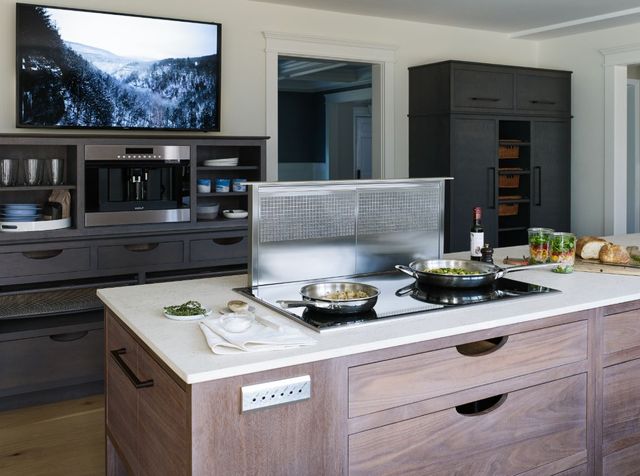
Thinking about switching to induction cooking, but don’t want a bulky overhead range hood hanging in the middle of your kitchen? You're not alone. More and more homeowners are looking for a clean, open-concept kitchen—and searching for a solution for ventilation without a statement hood? A sleek induction cooktop downdraft setup.
At Arnold’s, we specialize in helping homeowners build smarter, more seamless kitchens. Whether you're eyeing a downdraft induction cooktop with a built-in vent or you're planning to pair your favorite induction cooktop with a separate downdraft ventilation system, you’ve got options. And this guide is here to walk you through all of them—plus help you get it installed the right way.

Induction cooking is booming—and for good reason. It’s fast, precise, energy-efficient, and ultra-easy to clean. But here’s the catch: if you want to ditch the traditional overhead hood, you’re going to need a plan for ventilation. Enter the induction cooktop with downdraft, a solution that sucks steam, smoke, and odors down through the countertop instead of up through a hood.
This setup is perfect for island installations, minimalistic kitchens, or anyone who just wants to keep their view free of a range hood. Some induction cooktops come with the downdraft built in, while others can be paired with a separate downdraft system. Both are totally doable—and available right here at Arnold’s Appliance.
Shop Downdraft Cooktops in Bellevue
Find a new downdraft cooktop from leading brands at Arnold's Appliance, today!
Shop Downdraft Cooktops Near MeWhether you're designing a modern kitchen from scratch or retrofitting your space with a 30-inch induction cooktop with downdraft, we’ll show you what to expect, how to shop, and how to get it installed without a hitch.
→ Learn more: Comparing Cooktops vs Rangetops for Your Kitchen
What is Induction Cooktop Downdraft Venting
So, what exactly is induction cooktop downdraft venting? In short, it’s a ventilation system that pulls air down and out, directly from your cooktop surface. Instead of a range hood mounted above your stove, downdraft systems either rise from behind the cooktop or are integrated directly into it—depending on the model.
There are two main ways to do this:
- Built-In Downdraft Cooktops: These are models where the cooktop and ventilation are built into one unit. Think JennAir, Miele, or KitchenAid. The vent is typically located between the burners and quietly draws air down and out through ductwork.
- Downdraft Range Hoods: These systems are installed behind or beside your induction cooktop and operate independently. Brands like Broan and Best make reliable units that pair well with many induction downdraft cooktops, giving you more flexibility when choosing your cooktop brand.
The good news? Arnold’s carries both options. Whether you're looking for a full induction cooktop with downdraft ventilation built-in or you want to custom-pair your cooktop and vent, our experts can help you find the right fit for your kitchen, your budget, and your cooking style.
→ Learn more: 36 Inch Electric Cooktops: 6 Best Reviewed Models
What to Know Before Switching to Induction with Downdraft
Making the switch to induction cooking is exciting—but you’ll want to prep for a few key things when planning your downdraft cooktop induction setup.
1. Space & Measurements
A standard 30” induction cooktop with downdraft ventilation fits well in most kitchen counters or islands, but don’t assume—it’s essential to measure your cutout space and check the depth of cabinetry beneath, especially if you’re retrofitting an existing cooktop. Downdraft systems often require space below the surface for the blower motor and ducting.
2. Ventilation Power

Ventilation systems are rated by CFMs (cubic feet per minute). Most downdrafts run between 300 and 600 CFM. For most residential cooking, 400–500 CFM is plenty, but if you cook frequently with high heat (or do a lot of searing), you may want a more powerful motor.
3. Ducting
Your downdraft vent may need to connect to exterior ductwork. If mounted in an island, it could go through the floor, wall, or back. Be prepared for ducting and potentially extra cabinetry modifications. You could also choose an option that recirculates the air in your kitchen to avoid venting.
4. Electrical & Venting Considerations
Induction cooktops require a 240V connection and a dedicated breaker. Downdraft vents need their own power supply too. If you're going for a combo unit, be sure to check how many circuits are required.
5. Professional Installation Is a Must

This isn't a DIY kind of job. Installing an induction cooktop with downdraft vent involves cabinetry, electrical work, and ventilation—so professional installation is the way to go. The team at Arnold’s can help coordinate everything from start to finish.
→ Learn more: How to Switch to a 36" Cooktop
How to Install an Induction Cooktop with Downdraft
Installing a downdraft system for an induction cooktop is more involved than just dropping in a standard cooktop. Between electrical requirements and venting logistics, there are a few moving parts that make this job best left to the pros. But it’s still helpful to know what the process looks like—especially if you’re building a new kitchen or retrofitting an old one. Here’s a breakdown of what to expect during installation:
Step 1: Measure Your Cutout and Cabinet Space

Start with accurate dimensions—not just for the surface cutout, but also for the cabinet below. Remember, a 30” induction cooktop with downdraft ventilation may require extra depth or clearance underneath to house the ventilation system and blower motor. You’ll also need to account for ducting routes (down, back, or sideways) and electrical access.
Pro Tip:
Don’t forget to factor in countertop thickness and cabinet wall spacing. Downdraft vents often need more room than you’d expect behind the cooktop.
Step 2: Plan Your Ducting Route
Downdraft systems require a clear path for air to escape—usually out through an exterior wall. Depending on your layout, the ducting may be routed in different ways:
- Down through the base cabinet and floor
- Straight out through the back of the cabinet
- Or to the side, depending on blower placement
Flexible ducting is not recommended for high-performance downdrafts, so your installer will likely use rigid ducting to maintain airflow efficiency. The shorter and straighter the path, the better the performance.
Step 3: Prepare Electrical Wiring
Induction cooktops require a 240V connection and often pull 30–50 amps depending on the model. Downdraft vents need their own power source, too. Your electrician will make sure both circuits are wired, grounded, and ready to go before the appliances are installed.
Note:
If you're installing a combo unit (where the cooktop and downdraft are one), double-check the power requirements. Some models need two circuits, especially if they have powerful ventilation systems.
Step 4: Install the Downdraft Unit

If your setup uses a separate downdraft system, that gets installed first. It’s typically mounted directly behind or beside the cooktop cutout and secured to the base cabinet. The ducting is connected to the blower, and the unit is tested for proper alignment and clearance before the cooktop goes in.
Optional Add-On:
Some homeowners choose to install a remote blower (mounted outside or in a basement) for ultra-quiet operation. Ask Arnold’s if that’s something you want to explore.
Step 5: Drop In and Secure the Induction Cooktop
With the downdraft in place, the cooktop is carefully lowered into the cutout. Installers will use mounting brackets or clips to secure it per the manufacturer’s instructions. If you’re working with a combo unit—this is when both the induction and downdraft components are wired up and tested.
Silicone sealant is usually applied around the edge of the cooktop to protect from spills and keep the install looking clean.
Step 6: Final Test and Finishing Touches
Once everything is connected, your installer will test
- All burner zones for power and temperature response
- Ventilation strength and airflow direction
- Any touchscreen or control panel features
- Overall noise levels and airflow clearance
Cabinet doors and drawers are checked for interference, and airflow is measured to make sure your induction cooktop with downdraft vent is functioning as it should.
Learn more: Is Induction Better Than Gas?
Bottom line? This project isn’t your average DIY cooktop swap. Installing induction downdraft cooktops requires careful planning and expert hands. At Arnold’s, we partner with certified installers who know how to protect your investment and make sure your new cooking system looks and works perfectly from day one. Whether it’s a sleek island installation or a complete kitchen remodel, we’ve got you covered from consultation to cleanup.
Shopping for Induction Cooktops with Downdraft

Shopping for an induction cooktop with downdraft isn’t hard—but it does take some know-how. Here’s how to make sure you get the right setup:
- Decide on Configuration: Do you want a cooktop with downdraft built in, or do you want to pick a separate induction cooktop and downdraft system? Both work—your kitchen layout might help make that decision.
- Check Sizes: Most common sizes are 30-inch induction cooktops with downdraft, but 36-inch models are also available. Measure your space first to avoid headaches.
- Think Venting Logistics: Downdrafts require room for ducting. Islands and exterior walls are ideal locations. If you’re limited, Arnold’s can help you find a model that fits your layout.
- Don’t Skip Quality: Not all downdraft systems are created equal. Some cooktops perform better than others with ventilation. Brands like JennAir and Miele have engineered their own induction downdraft cooktops to be seamless.
At Arnold’s Appliance, our appliance experts will help you pick the perfect pairing—whether you want an all-in-one unit or a custom system. We carry premium brands and offer installation support from start to finish.
→ Learn more: Is Bosch's Induction Cooktop Worth the Switch? Our Review
Ready to make the switch? Whether you're drawn to the sleek design, efficient performance, or the idea of ditching your bulky hood, induction cooktop downdraft systems offer the best of both worlds. From seamless ventilation to lightning-fast cooking, this setup checks every box for modern kitchen lovers.
Visit Arnold’s Appliance today to explore the best induction cooktop with downdraft ventilation options—and let our team help you cook smarter, cleaner, and in style.
Induction Cooktop with Downdraft FAQ
Yes, absolutely. Several premium brands like JennAir and KitchenAid offer induction cooktops with downdraft built directly into the unit. You can also purchase a separate downdraft ventilation system and pair it with your favorite induction cooktop for a fully customized setup.
Not all induction cooktops have downdraft built in, but many do. If a model does not include a downdraft vent, you can still pair it with an independent downdraft system. At Arnold’s, we help customers mix and match to find the best downdraft cooktop induction solution for their space and cooking needs.
Technically, no—you don’t need a downdraft vent. But like any cooktop, you do need ventilation of some kind to remove steam, odors, and smoke. If you don’t want a bulky overhead range hood, a downdraft vent is a great, low-profile alternative—especially for island cooktops or open kitchens.
Your best bet for induction downdraft cooktops in Bellevue is Arnold’s Appliance. We carry top-rated induction cooktop downdraft models, expert advice, and professional installation. Whether you're after a built-in system or want help designing your own setup, Arnold’s is your go-to for reliable brands and personalized service.
Why Trust Arnold’s Appliance?
Arnold's Appliance started in the summer of 1956 when it opened its doors as Lakeshore Appliance in Redmond, Washington. John Arnold and his family have since grown the store from just a few brands to the large appliance store it is today and moved to Bellevue in 1999 in search of a larger building. Arnold’s Appliance now offers high-end innovative products from over 45 manufacturers.
In addition to extensive product knowledge, Arnold’s has been providing fine appliances to Northwest builders, remodelers, designers, architects, and developers for over 47 years. Arnold's supplies products and installation to many of the finest custom and spec home builders in the Pacific Northwest. Along with single-family housing, Arnold's has also supplied products for some of the largest multi-unit projects in the area. Arnold’s, now the third generation of the Arnold Family, is dedicated to bringing the best quality products, delivery services, and installation to customers for years to come.
Shop Induction Cooktops at Arnold’s Appliance
Stop by Arnold’s Appliance Bellevue, WA location to see what a difference buying locally with an experienced staff can make. Or shop induction cooktops online! Our friendly experts are always happy to help you choose an induction cooktop with downdraft ventilation— whether you call us at 425-454-7929, use our online chat feature, or visit us in person.
→ Learn more: Why Choose Jenn-Air Cooktops? Features, Costs & Installation
